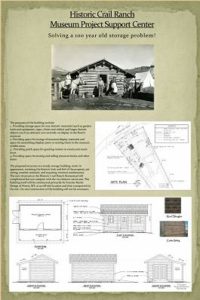Space Problems
Back in the early 1900s, the Crails had a space problem — a family of five living in a 255 square foot cabin. Over 100 years later, Crail Ranch still had a space and storage problem! The historic small cabin, first occupied by the Crails, had become a repository for museum support materials including chairs, tables, gardening equipment, canopies, etc.

Project Center Plans
A Plan for Action
During the summer of 2013, the Crail Ranch Homestead Museum Conservators set an ambitious goal to bring another structure to the site to house all of these items and to serve as a staging area for Crail Ranch projects.
Preliminary plans and cost estimates for the building were drawn up by the Conservators and professional drawings were prepared by Janet Storey of Storey Architects. The project was approved by the Big Sky Architectural Committee of the Big Sky Owners’ Association.
The building was constructed primarily by Frontier Rustic Design of Ennis. Two other companies did key contract work on the project: Lone Peak Electric, LLC (Ryan Lacey) and Lone Pine Builders (doing the site excavation).

Brian Frederick of Big Sky landscaping sets gravel for the foundation and “moves the Rocky Mountains.”

Frontier Rustic Design of Ennis, Montana delivers the porch section of the new Crail Ranch Museum Project Center.
Funding & Community Support
Funding appeared at first to be a major issue, but the Rotary Club of Big Sky stepped forward to give the Conservators a big boost toward their goal. According to Rotarian Dr. Jeff Strickler, “We were looking for a project, and helping another non-profit accomplish its goals was part of our plan. The new structure at Crail Ranch seemed a perfect fit.”
Additional funds to enable the Conservators to begin work were obtained from several other sources including the Buck and Helen Knight Foundation and the Big Sky Owners’ Association.
Crail Ranch Conservator Chair Anne Marie Mistretta says, “As word of our needs went out to the Big Sky Community, help wasn’t long in coming.” Among the local companies who volunteered outstanding in-kind professional support were E L Painting and Lone Pine Builders.
“The comprehensive cost of the building, including everything, was approximately $30,000” says Mistretta. “HCRC paid less than 1/3 of those costs out of operating budgets because of the generosity of the community.”
Read the article Download pdf

Our new Museum Project Center finally in place late-July 2014!
BSCO Public Trails
BSCO manages 23+ miles of trails that are all multi-use and multi-directional.
Ralph’s Pass (closed in winter)
Info & Maps:
Multi-Seasonal Use
The majority of BSCO trails are open year-round, barring any temporary seasonal hazard closures.
= Groomed or plowed during the winter.Note: Ungroomed / plowed trails are still open & get packed down by use.
BSCO Projects
We are always looking at opportunities to increase parklands and open spaces while further developing public recreation amenities.
Get Involved
More Ways to Give
Support a campaign, donate stock or explore naming & sponsorship opportunities.
